#oedipus complex
Text
2K notes
·
View notes
Text

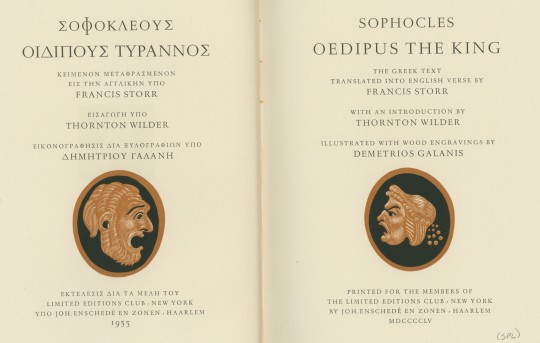



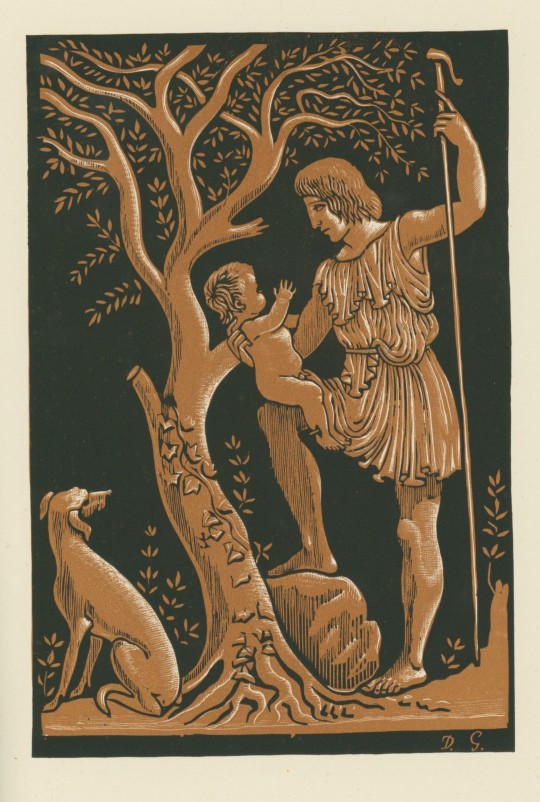
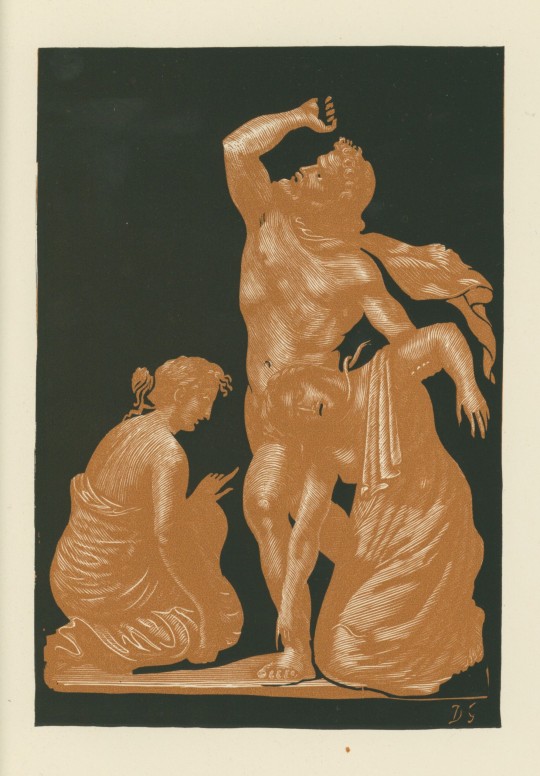

Tragically Greek
This 1955 edition of Oedipus the King, written by Sophocles, features the original Greek text alongside the English verse translation. Offering a rich, immersive reading experience results from hard work, dedication, and creative minds coming together to create this masterpiece.
Jan van Krimpen (1892-1958), Dutch typographer, book designer, and type designer, designed the two typefaces. The Greek type is named “Antigone,” and the English type is called “Romulus.” The translator for this work was Francis Storr (1839-1919), a British classicist, translator, and teacher.
The paper was specially manufactured at the historic Dutch Pannekoek Papermill, a mill with a rich history that unfortunately met its end in a fire in 1944. This exclusive feature adds a touch of rarity to your reading experience. Printed in the offices of Johannes Enschedé, under the supervision of Mijnheer van Krimpen, it was for the members of the Limited Editions Club.
Adding to the richness of this edition is the detailed and insightful introduction provided by Pulitzer Prize winner Thornton Wilder (1897-1975), American playwright, novelist, and native of Madison, WI. His esteemed perspective offers an enlightening preface to the classic tale.
The illustrations are black and terra-cotta wood engravings designed by Greek artist Demetrios Galanis (1879-1966). He was the trailblazer of modern Greek engraving and was once touted as one of the greatest living Greek artists at the time of the book’s release.
Sophocles (c. 497/496 – winter 406/405 BC) was an ancient Greek playwright born in Colonus near Athens. He is one of the three great tragedians of classical Athens, along with Aeschylus and Euripides. Sophocles wrote over 120 plays during his lifetime, although only seven have survived in their entirety. His works are characterized by their complex characters, well-crafted plots, and profound exploration of moral and philosophical themes.
Among his most famous plays is the tragedy Oedipus the King. The story is about Oedipus, the king of Thebes, who tries to uncover the truth behind a plague that has struck his city. In doing so, he discovers that he himself is responsible for the plague, having unknowingly killed his father and married his mother. The play delves into themes of fate, free will, and the consequences of one's actions.
-Melissa, Special Collections Classics Intern
View other Classics posts
#classics#sophocles#oedipus#oedipus rex#oedipus the king#greek mythology#greek#wood engraving#athens#tragedy#greek tragedy#ancient greece#oedipus complex#Limited Editions Club#Johannes Enschedé#Enschedé#Jan van Krimpen#Antigone type#Romulus type#Francis Storr#Demetrios Galanis#Pannekoek paper#LEC#Thornton Wilder
52 notes
·
View notes
Text
Sigmund Freud is the OGMF
(original mother fucker)
53 notes
·
View notes
Text
The prevalence of your mom jokes and sleeping with your mom jokes with the associated intended ego wound prove the oedipus complex btw
12 notes
·
View notes
Text
Freud would read my Tumblr posts and immediately attempt to diagnose me with wants to fuck my mother syndrome but what's this? I am shooting him in the chest over and over again because he doesn't deserve the effort of me laying my hands on him.
28 notes
·
View notes
Note
Delighted that you enjoy my Posts. Also delighted to meet a fellow pervert. LOL! We share a few kinks, including a woman's foot fetish,
Your blog is totally awesome and very erotic. It causes many fantasies, thoughts, and ideas for me. Yes we do share a few kinks, including a woman's foot fetish. My woman's foot fetish is so overwhelming I am unable to function in public as I am uncontrollably staring at women's feet in public (matters not how beautiful or not the woman is, or her size, or anything else). Thank you for doing your blog as you do!
34 notes
·
View notes
Text
Everytime diabolik lovers features a scene involving a child and a parent Sigmund Freud's ghost becomes a little stronger.
#sigmund freud#freudism#psychology#oedipus complex#diabolik lovers#jk jk... unless?#ayato sakamaki#kanato sakamaki#especially#laito sakamaki#ok maybe just the triplets#but also#reiji sakamaki#if you squint
19 notes
·
View notes
Text
Recovering the maternal in art
Thoughts on Hamlet #1
A crazed rant on Hamlet, art in modernity, Susan Sontag, and female power in Christian theology

The feminine urge to be daddy's mommy. — — Natalie Wynn, Contrapoints
This is the first of my series of meditations based on Shakespeare’s Hamlet, which I have been studying as part of English literature A-level. It is the basis on which I expand into wider general reflections on culture and philosophy, linking to other things I’ve read or watched recently.
This piece begins as art criticism about excessive author presence in modern art, with allusion to Hamlet as an embodiment of such modern artist. But then it kind of diverges into a theological tangent and ultimately an argument about gender and female power in Christian myths.
It doesn’t really neatly belong to any specific literary category. It is essay-like, but is full of poetic logic. Perhaps just read it as a kind of unhinged diary entry or notes app notes that should have stayed in the drafts.
— — Z
1
Modern authors, perhaps due to their peculiar awareness of themselves as authors, have felt this exceeding sense of self-inflicted obligation, that they have to force their authorships onto the audience, to make them aware that what they’re seeing, is in fact, created by them. And not just by the world.

‘What a piece of work / Is a man!’ Hamlet, II, ii, 301–302
What I mean by this could be seen most obviously in the attempt that modern authors try to push “message” into their works, or simply the conscious attempt to have any message at all. Consciousness is really the crime here. There is a kind of forcedness in modern art, a lack of the grace, the relaxed effortlessness that is so prevalent in classical, canonical art. Modern art is always agitating, in a permanent state of anxiety and uncertainty in whether it has “correctly” communicated its message to its audience.
Notes: Hamlet is seen by many as Shakespeare’s most philosophical play, his most message-heavy work, with deep contemplations on the nature of existence.
The long soliloquies of the eponymous prince has long been described as rigorously academic in style, perhaps most famously, in the ‘to be or not to be’ soliloquy. It is the most decontextualised soliloquy uttered by the prince, in which he solely speaks on the conceptual matters of life and death.
Yet this intellectual aspect of the play might perhaps what Shakespeare precisely is trying to satirise here. A tormenting, self-cannibalising, painful intellectual interiority, emerging in the early modern West, with its deep Christian moralism and inhuman rationalism, is here presented as precisely what drives the main character, and those around him, into misfortunes.
‘O, what a rogue and peasant slave am I!’
Hamlet, II. ii. 538
The dramatic forcedness of Hamlet's messaging is perhaps most evident in the almost ravage-like scene in Gertrude's chamber (III, vi), in which he almost embodies the incestuous and murderous Nero.
'Let not ever
The soul of Nero enter this firm bosom.
Let me be cruel, not unnatural.'
III. ii. 366-368
Susan Sontag said that art should be flirtation, not rape. Well, many modern art feels like rape to me. They feel like rape in the way that they try to force one singular thing onto its recipient. It refuses a defused, tender sensuality that slowly transmits and triggers desires through a landscape of polyamorous tenderness. Instead, it is strictly patriarchal, scriptural, the word of the Father, of God, Author The Creator. There is a violence to it. But more so there is a naivety to it.
The violence is in the naivety. In its brutal attempt to not appear naive, but rather adultly, scholarly, fatherly, like the son who resolves the Oedipus complex by identifying with the father to escape the fate of castration. The dwarf dressed in the giant’s robes.
‘But two months dead — nay, not so much, not two-
So excellent a king, that was to this
Hyperion to a satyr, so loving to my mother
That he might not beteem the winds of heaven
Visit her face too roughly. Heaven and earth!’
‘My father’s brother, but no more like my father/ Than I to Hercules’
Hamlet comparing his father to his uncle, the current King Cladius, and himself, I. ii. 138–142; 153–154
This is the modern author. The anxious son, boy, fearing castration, if not already castrated, living in the shadow of the father, haunted by him, resenting his mother, the wanton, the whore, the true artistry of the world.


Hamlet (1949). Laurence Olivier
True art is always promiscuous. She is the Saint of All Sins. The Virgin in the Brothel. The Whore in the Church. The Holy Witch. The High Priestess of Filth. She is a woman. She is mother. The Oracle (whose words are obscure because they’re divine, not to Him the God, but the real, hedonistic god of music and joy, through whom she is enlightened in darkness). The Sea. Shall I moor tonight in thee.

Twilight, Contrapoints, Natalie Wynn
He, the God, and Her, Nature, whose fundamental battle is once again reenacted in this.
Genesis 1:2, the Spirit of God moved upon the face of waters. God moved on top of the sea, God on nature, man on woman, reason on art, this is the fundamental violation, the real original sin, the forbidden fruit of knowledge, brought forth by Himself through his very presence. The fault of the Fall is not in us. It is in Him. For to be holy is to be aware of the profane, as the opposite is equally true. Therefore to be profane, to be sinful, is precisely to be aware of the existence of the hallow. To learn about it. To aspire to it. Without sin, there would be no God. Like there would be no man without woman.
‘Whatever is the subject of a prohibition is basically sacred’.
‘The taboo does not banish the transgression but, on the contrary, depends upon it, just as the transgression depends on the existence of the taboo: “The transgression does not deny the taboo but transcends it and completes it”.’
Georges Bataille, Eroticism: Death and Sensuality
‘That discourse one might call the poetry of transgression is also knowledge. He who transgresses not only breaks a rule. He goes somewhere that the others are not; and he knows something the others don’t know.’
Georges Bataille, Story of the Eye
Notes: St. Augustine of Hippo wrote that original sin is transmitted by concupiscence and enfeebles freedom of the will without destroying it. But isn’t will also what precisely drove one (Eve) to the origional sin? Perhaps the will is much like Kant’s conception of freedom, a thing that creates its own limits.
Without an elusive ideal to aspire to, we will never be aware of our skin-felt wretchedness. The fruit is not only planted by God, it is God, it is God who eats the fruit, it is God who is the fruit being eaten, and it is God who is watching all of this.
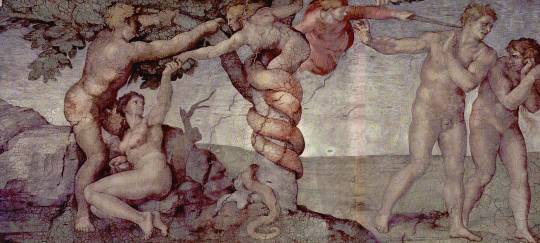
I find it interesting. The closeness between the angel and Satan. Almost mirror images. In Michelangelo’s painting of the sin of Adam and Eve from the Sistine Chapel ceiling.
The decision to have the woman be the one to eat the fruit therefore, is interesting, on multiple levels. She is the original sinner, but also the one closest to God. For the fruit is God, but the fruit is also sin, and it is through the death of the man that she (gives birth to) achieves salvation. She is sin, but she is sin in grace, the glorified sin, the sin made divine, the virgin who gives birth, saved from stoning (here she also mirrors the other Mary, the other permitted sinner, Mary Magdalen), who gives birth to the man who is going to die, through which she successfully redeems herself. She is the mother, and she is the sinner, the original in both, and in both she is holy.
Eve is Mary and Mary is Eve.
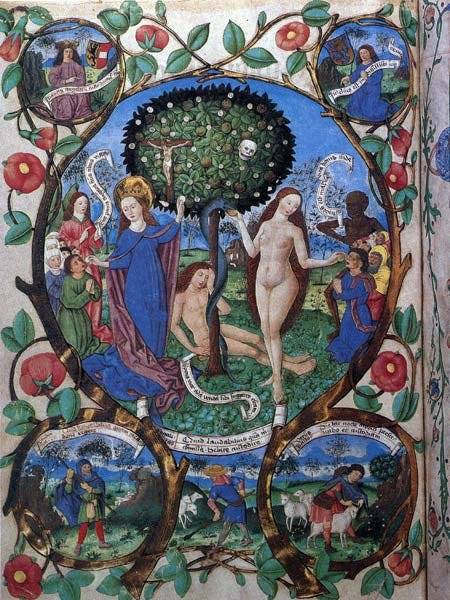
The tree of death and of life in the Salzburg Missal: Eve gives the representatives of the old covenant the fruit that brings sin and death from the tree of paradise. Mary, on the other hand, gives the faith hosts, the bread of life. — — The New Eve (Latin: Nova Eva) is a devotional title for Mary, the mother of Jesus. Since the second century, numerous Eastern and Western Church fathers have expressed this doctrinal idea as an analogy to the biblical concept of the New Adam.
The man is essentially an accessory to her, a passage through which she penetrates through to achieve her eventual goal. He is only a thing that she decorates herself with. The baby in her bosom. The man on her laps (Pietà). The feminine urge to be daddy’s mommy. The gravedigger, whose death goes unmentioned, outlived everyone. Her blue robe is serene, like the halcyon sea.

Sandro Botticelli’s Madonna and Child, painted in 1480, shows a reflective Mary in deep blue.
Z
17.03.2024
(with notes later added 24.03.24)
Source:
Susan Sontag, Against Interpretation, On Style, The artist as examplary sufferer
Natalie Wynn, Contrapoints, Twilight
Georges Bataille, Eroticism: Death and Sensuality, Story of the Eye
Janet Adelman, Man and Wife Is One Flesh: Hamlet and the Confrontation with the Maternal Body
I have also posted this on Medium.
#shakespeare#hamlet#oedipus complex#literature#feminism#catholic core#philosophy#contrapoints#natalie wynn#twilight#georges bataille#eroticism#susan sontag#art criticism#art#literary analysis#literary criticism#diary#rambles#the virgin mary#symbolism#renaissance#ideas#theology#women in art#thoughts#oedipal complex#freudian#mommy issues
14 notes
·
View notes
Text
anyone else get the feeling it's possible vogelbaum lied to homelander about what happened to becca *with* the truth of what happened to his own mother/surrogate (exception to artificial womb of course but this *is* vought which i feel makes the most ethically responsible choice for bringing a super fetus to term somehow the least viable for them)?
also, been wondering a little while what the hell stormfront hated vogelbaum so much for (doubtful it was what happened to homelander given how much she LOVED how he turned out...) and it had me wondering leik...
did he steal an egg from her or something? is that the set up here??
and then of course, the spiral.
gais, think homelander might *actually* be oedipus here, or at least set up to become oedipus (just the killing his father thing left over)... but color me shocked if they don't go full oedipus with homelander.
#homelander#the boys#the boys meta#jonah vogelbaum#just thinkin' i guess#john gillman#homelander meta#meta#stormfront#oedipus#oedipus complex#y'all
8 notes
·
View notes
Text
due to my father i’m evil now
#deadbeat dad#dysfunctional family#oedipus complex#electra complex#daddy issues#mommy issues#revenge#narcissistic dad#toxic people#toxic household#toxic parents#toxic father#abusive stepfather#abusive father#psycho
13 notes
·
View notes
Photo
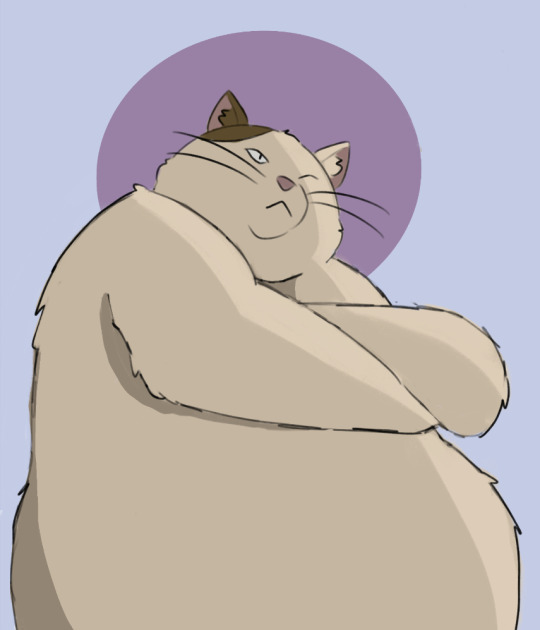
Little man big man!!
53 notes
·
View notes
Text
Sigmund Freud would be very happy with how Yoshiki sees his relationship with ‘Hikaru’.
#I know why literature does this#Doesn’t mean I like how often it appears#Man I hate sigmund Freud so much…#the summer hikaru died#hikaru ga shinda natsu#hgsn#I could go on a whole rant about this#Oedipus complex#yoshiki tsujinaka#Hikaru indoh#My hgsn shit
18 notes
·
View notes
Text
Person: I can never forgive the gods for what they did to Oedipus!
Me: You can't forgive the gods for being featured in a story someone wrote because they wanted to win a Sadness contest?
Person: what?
Me: I said, you can't forgive the gods because an ancient tragedy writer who wanted to win a contest by making the saddest story possible used the gods and the theme of fate to beat up Oedipus?
Person: but—
Me: Ancient Greece had tragedy contests to see how sad something could get because there was so much death around that people didn't have time to properly mourne so they had these story contests to make people cry because it was very cathartic for them.
Person: ...
Me: They used the gods because secularism wasn't a thing back then and nonsecular speech was very common, as an example as a Spanish speaker, in Spanish "Adios" literally translates into "to God" as in "our fate is in the hands of God now" as a form of goodbye to show an example of very religious speech used regularly, so the ancient Greeks often used religious speech when talking about fate and such.
Context matters!

209 notes
·
View notes
Text
i was watching a video essay and the guy brought up the oedipus complex as a valid argument and i stopped watching the video, and i just realised, that was the first time in my life i actually thought "this is bullshit i'm gonna stop believing this person" which makes me worried about the past several years of internet browsing that ocurred without that happening even once
4 notes
·
View notes
Text
Bro what the fuck i was playing with a katara ai and it gave her oedipus complex 😭😭😭😭😭😭😭😭
#atla#avatar the last airbender#my post#atla shitpost#tw incest#oedipus complex#i was writing a soft little conversation between her and hakoda and suddwnly she goes “yeah i can bang that”#WTF 😭😭😭#💀💀💀
7 notes
·
View notes
Text
I am in the mood to do a bunch more posts and reposts related to my mom and or my "secret" relationship with my mom. All with the purpose of exposing my "secret" described on the header of my blog. Looking for suggestions. Should I do fantasies, truths, both, or something else. Will do what is suggested.
Every picture posted by the people I follow causes me to think 'I would really really love to see my mother wearing that'. Then the pictures cause me to form fantasies about my mother, or to think of truths about my mother and I and our secret affair. I tend to automatically speak, write, and post the fantasy or the truth about my mother and I and our secret affair that I am thinking about because of these pictures. Especially pictures of seamed nylons/seamed pantyhose, nylon layers, pantyhose gussets, fishnet nylons/fishnet pantyhose, slingback high heels, thigh high boots. Open toe shoes/sandals, and or blue toenail polish creates fantasies/truths about my foot fetishes (you can imagine me out in public in summertime here).
34 notes
·
View notes